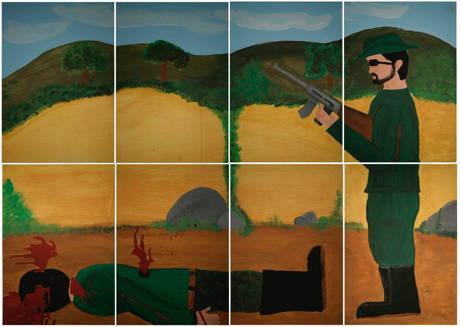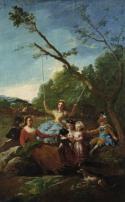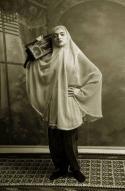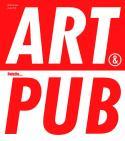Art Of The Day Weekly
#410 - from 10 December 2015 to 16 December 2015

Caliche, My first steps in war, 2007 © Fundación Juan Manuel Echavarría
IN THE AIR
Colombia, a war
BORDEAUX – If we could set up a classification in the scale of horrors committed during a war, the one that tore apart Colombia for decades following the Bogotazo in 1948 (the murder of the liberal leader Gaitán) is among the most cruel. As automatic weapons developed, Marxist guerrilla fighters became a tradition (M-19, ELN, FARC) and paramilitary militia stepped in, it led to unbearable episodes, such as massacres with chainsaws. A number of Colombian artists, Doris Salcedo or Oscar Muñoz for example, have used it as the axis of their work. One of them, Juan Manuel Echeverría, at his foundation Puntos de Encuentro (points of encounter), put this question forward to actors of this same tragedy. That is, he handed paintbrushes and canvases so they could express their experience and their interpretation. These 420 paintings, half way between raw testimony and psychotherapy– butchering, firing squads, hangings, rape – show that war is never pretty, not even when in colour, but human beings always manage to deal with daily horror.
• La guerre que nous n’avons pas vue at the Musée d’Aquitaine, from 11 December 2015 to 6 March 2016.
EXHIBITIONS

Francisco de Goya, La Balançoire ou L’Escarpolette, 1779, oil on canvas, Madrid, Museo del Prado © Madrid, Museo Nacional del Prado
Long live the fête galante!
LENS – Following the sad and bigoted years at the end of the life of Louis XIV, who died in 1715 without a direct heir aside from his very young great grandson (5-year old Louis XV), the court was famished for freedom and pleasure. Under the Regency of Philippe d’Orléans, nobles got dizzy with concerts, banquets and dances. It was the time of the “fêtes galantes”, represented by Watteau and Boucher, a time of the famous French lightness that spread throughout Europe, from painting to the decorative arts (Meissen porcelain with its scenes of Joyeuse leçon, wood marquetry furniture, saucy snuffboxes, etc.) The exhibition presents a tour through this art of living, this taste for jokes, these fresh feelings and emotions which today would do us so much good. Fragonard, Oudry, Gainsborough and even Goya, picnics and outings in country settings, afternoons on swings, secrets whispered and shared by shepherds and their sweethearts. The title of a song chosen by Madame de Pompadour gives the tone of a certain form of European civilisation which helps to bear the hazards of destiny. We would gladly take a second serving of just that …
• Dansez, embrassez qui vous voudrez at the Louvre Lens, from 5 December 2015 to 27 February 2016.
Zao-Wou-Ki, an assessment
MARTIGNY – He was a Chinese immigrant who had his share of trials and tribulations, starting with immigration, his addiction to whisky which led to his nickname “Zao Whisky”, a wife with mental problems. Yet he also met success. He was Jacques Chirac’s favourite artist and his work sold easily for more than €1 million. Zao Wou-Ki (1920-2013) spent three quarters of his life in the XIVth arrondissement in Paris, near Giacometti’s atelier in particular. He arrived there in 1948 and is now buried at the cemetery of Montparnasse, in the same district. He was very impressed by Klee’s work and quickly slipped away from his beginnings in figurative art to move on to a more personal abstraction. The exhibition traces 60 years of his career, from
• Zao Wou-Ki at the Fondation Gianadda, from December 2015 to 12 June 2016.
Multiple Istanbul
ROME – Some forty artists, from Hamra Abbas to Hasan Tur and including Sarkis, show the diversité of artistic creation in Istanbul. The demonstrations at the Gezi Park in 2013, the fundamentalist threat, the urban pressure or the "gentrification" of certain districts in the city: the themes chosen for the exhibition are varied and the answers show the artists are essential - and often committed - witnesses of their time.
• Istanbul. Passione, gioia, furore au MAXXI, from 11 December 2015 to 1 May 2016.
César in Morocco
RABAT - The musée Mohammed VI d’Art moderne et contemporain, which opened in 2014, is one of the rare new institutions in a region which these days is more often mentioned for the destruction of figurative culture. One of its first exhibitions is dedicated to French artist César (1921-1998), an emblematic figure of the Mediterranean individual open to various influences.
• César, une histoire méditerranéenne at the musée MMVI, from 9 December 2015 to 14 March 2016.
ARTIST OF THE WEEK
Shadi Ghadirian, an Iranian female photographer
Women from the Qajar era (1785-1925), from the constitutional era (1905-1907) or of today? They all are visible in the lens of Shadi Ghadirian, born in 1974. She is a representative of young Iranian photography, lived through the Revolution, the Irano-Irakian conflict, total censure and today's relative opening. Her photographs, in favour of the Iranian women's rights, are remarkably audacious, as they question the use of the veil, colour and gender. Some of them have become icons, as the author has had the surprise to discover some of them in schoolbooks of French History. There have been other series, many of them on the war that traumatized a whole generation. If Iran really opens to the world, Shadi Ghadirian could be one of its symbols, a pioneer among women photographers, a profession that was almost "unthought" of and "unthinkable" for women a quarter of a century ago.
• Shadi Ghadirian's work is shown at the Bibliothèque municipale in Lyons until 9 January 2016.
OPENINGS OF THE WEEK

Ernest Pignon-Ernest & Bruno Paccard - DANS LES PRISONS DE LYON (IN THE PRISONS OF LYONS)
10 December 2015 - LYON - Galerie Anne-Marie et Roland Pallade
Two visions on the prison Saint-Paul before it is demolished (drawing by Ernest Pignon-Ernest)
BOOKS
Is advertising an art form?
Andy Warhol drew a pair of golden clippers, Salvador Dalí the logo of the Chupa Chups lollipops, and before them, John Everett Millais had accepted in 1886 to see one of his paintings - a child blowing bubbles - be used by the makers of Pears soap. The relation between artists and advertising goes far back, and as this book shows, is double binding. On the one hand marketing uses art to sell – Nestlé took over Vermeer's Milk maid for there yoghurts and Manpower uses Leonardo's Vitruvian man. And these loans continue with Arcimboldo on the Malibu liqueur to Michel Angelo's David for Levi’s jeans. What would the artists themselves have thought of this? In the other sense, since Braque and Picasso included Pernod and the Kub instant broth in their paintings, artists continue to distort the meaning of the symbols of consumer society. Barbara Kruger, Erró, Wim Delvoye and Ai Weiwei (with his Chinese jug with Coca-Cola stamped on it) are just some of the party poopers.
• Art & Pub, by Mélanie Gentil, published by Palette, 2015, €24.50
IN BRIEF
BRUSSELS – The ADAM (Atomium Design and Art Museum), with a design collection from the 1960s to today, will open to the public on 11 December 2015.
LONDON - The 2015 Turner Prize has been awarded to the Group Assemble.
PARIS – SOON, the fair dedicated to numbered, original art works will be held from 11 to 13 December 2015 at the Bastille Design Center.
PARIS – French, German and Italian Culture Ministres have asked the European Commission to create a legal tool to fight the illegal import of cultural goods. This could help put an end to one of the means of financing of terrorist organizations.




